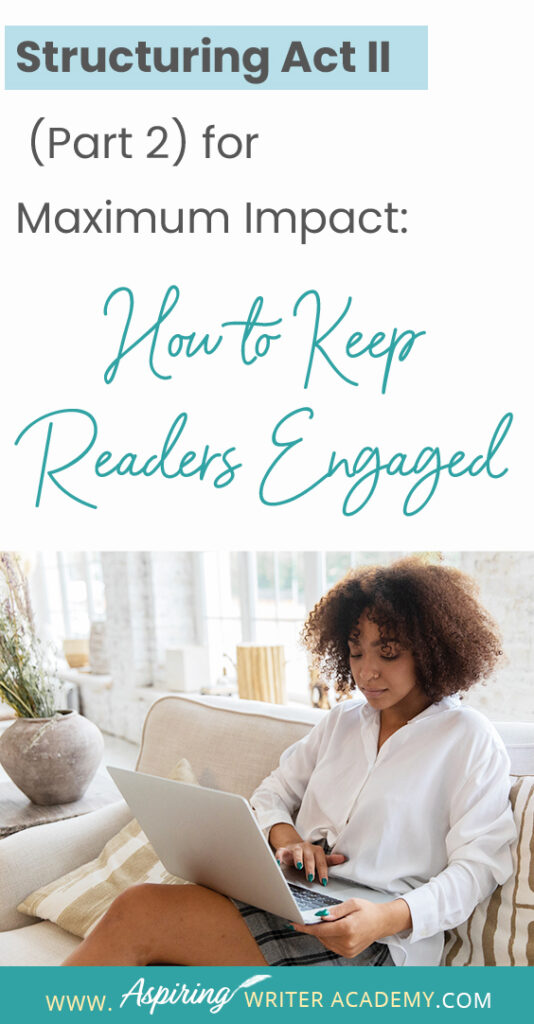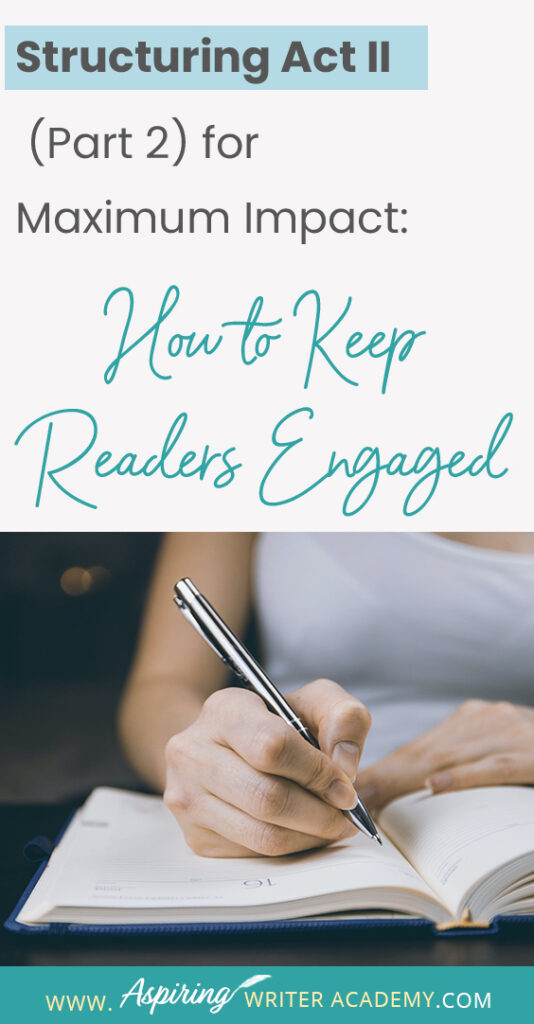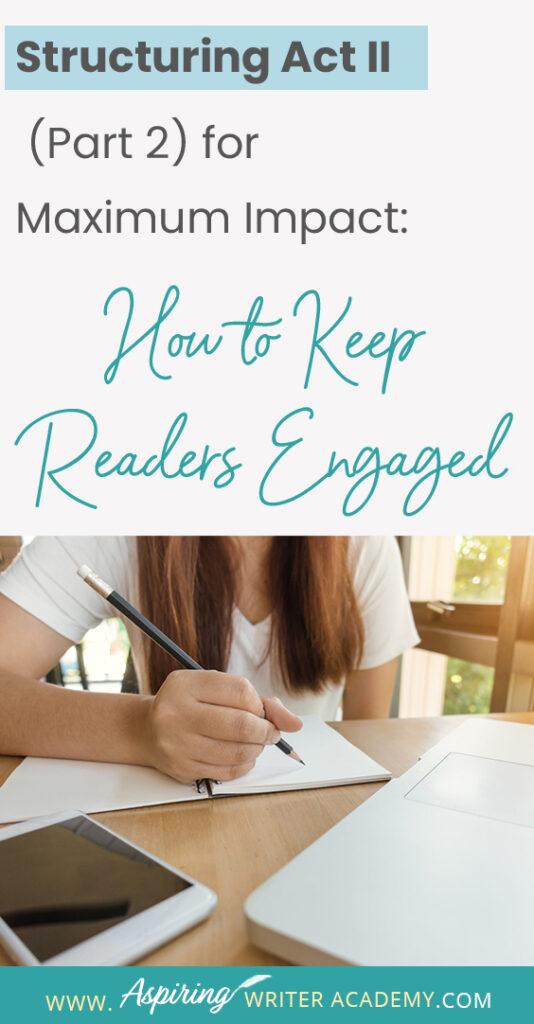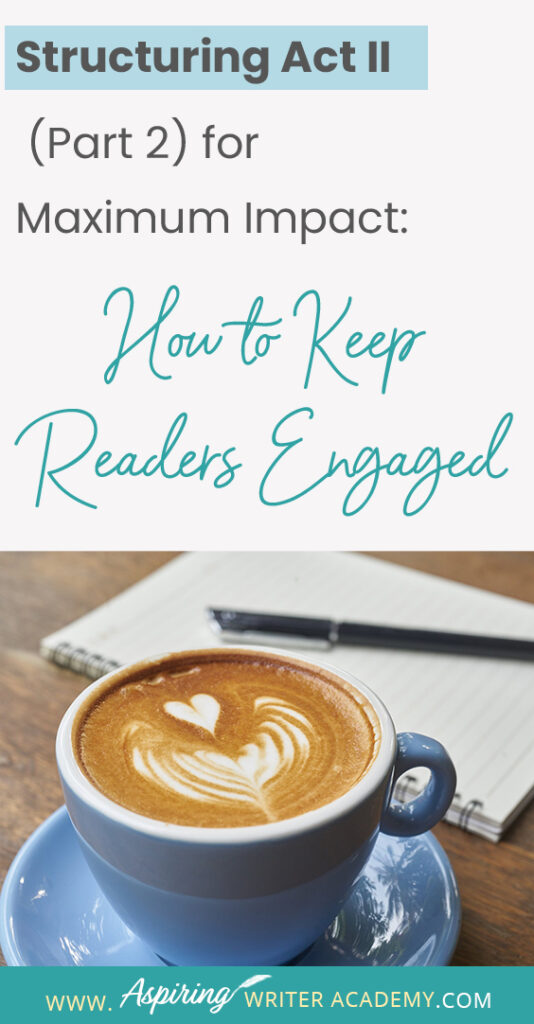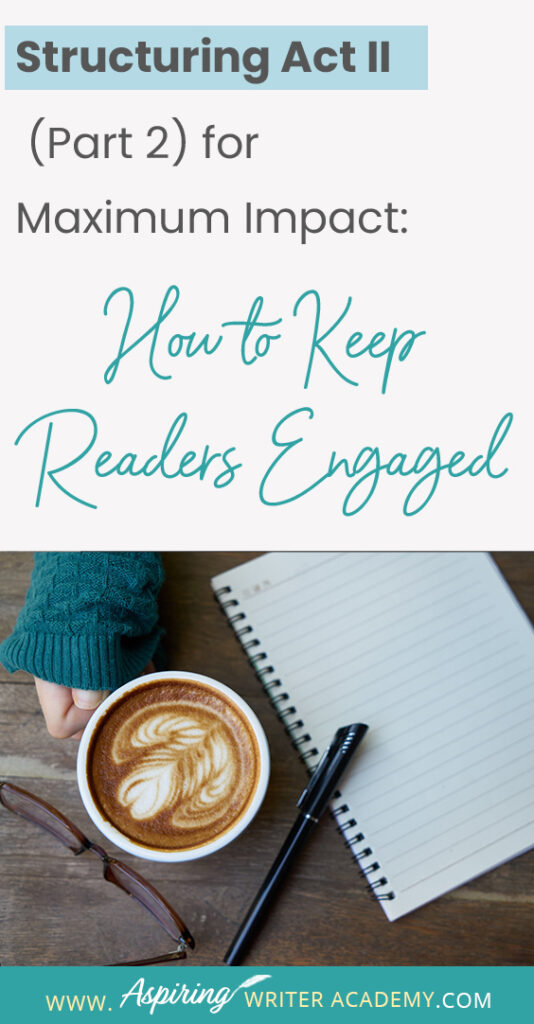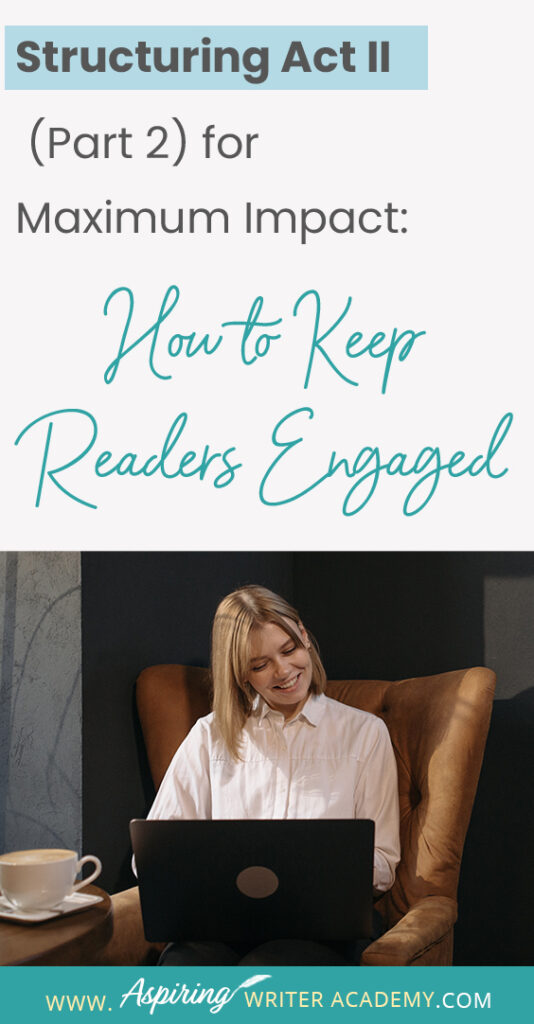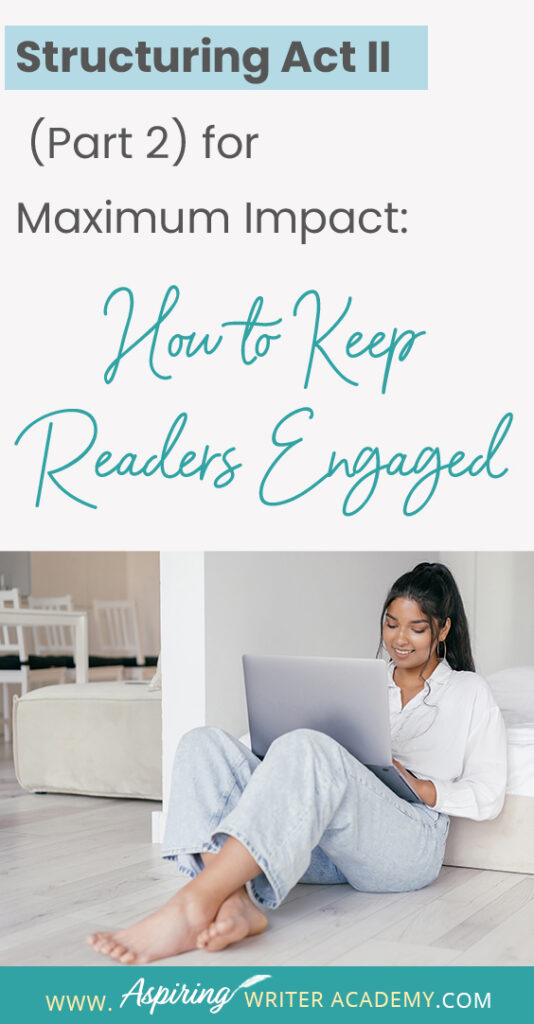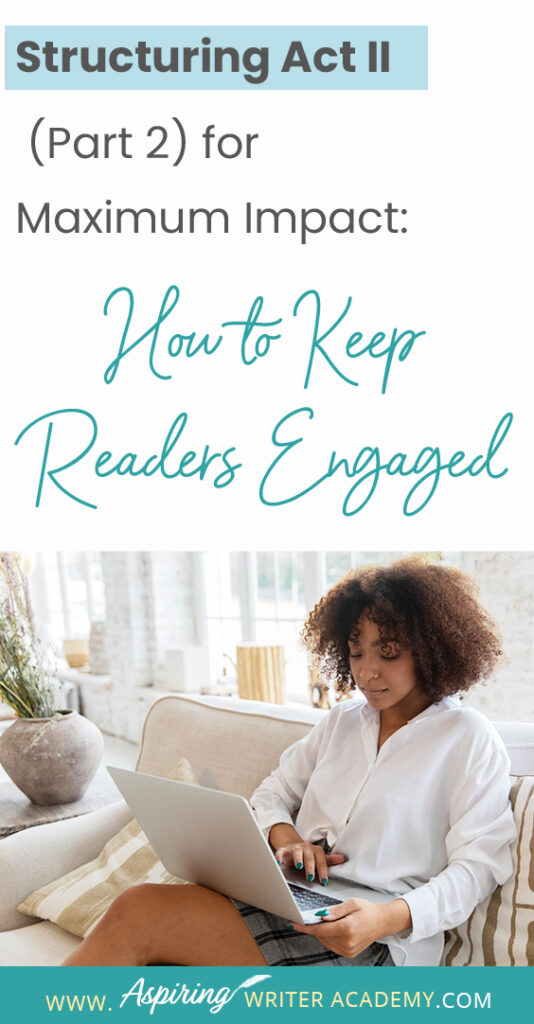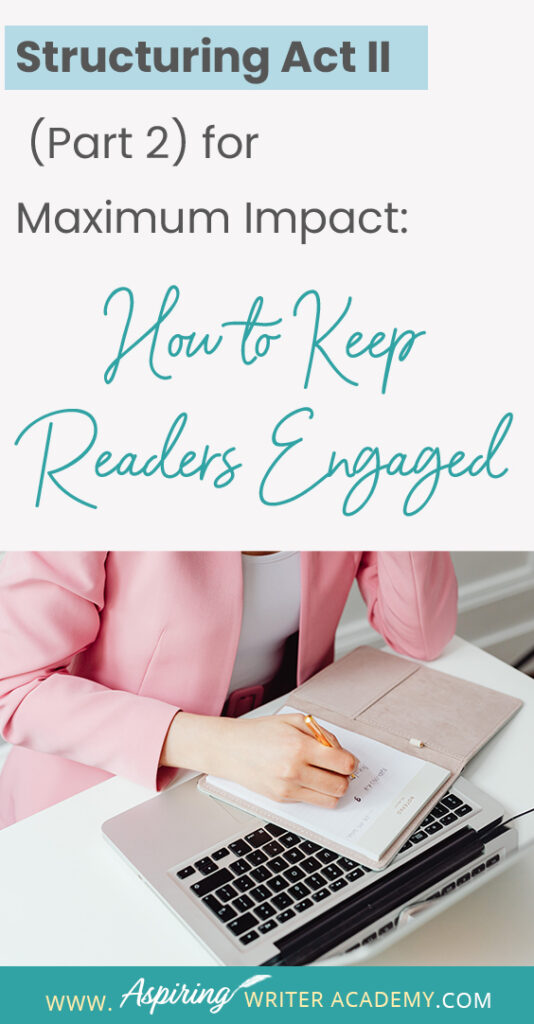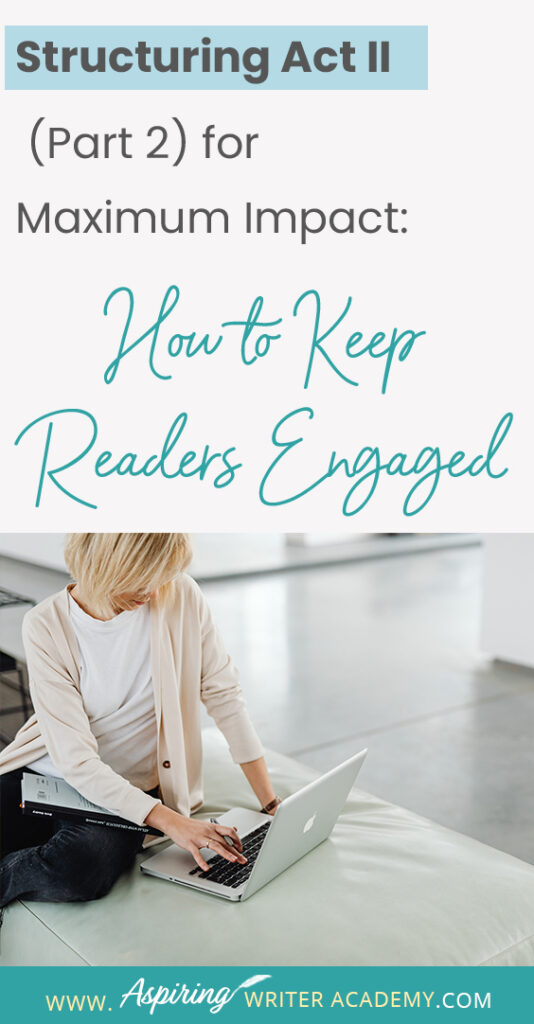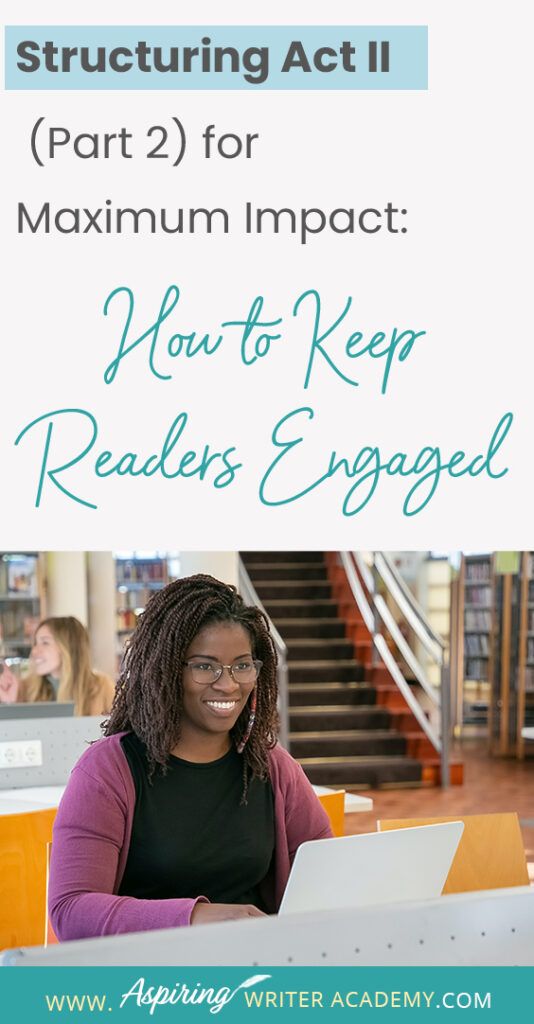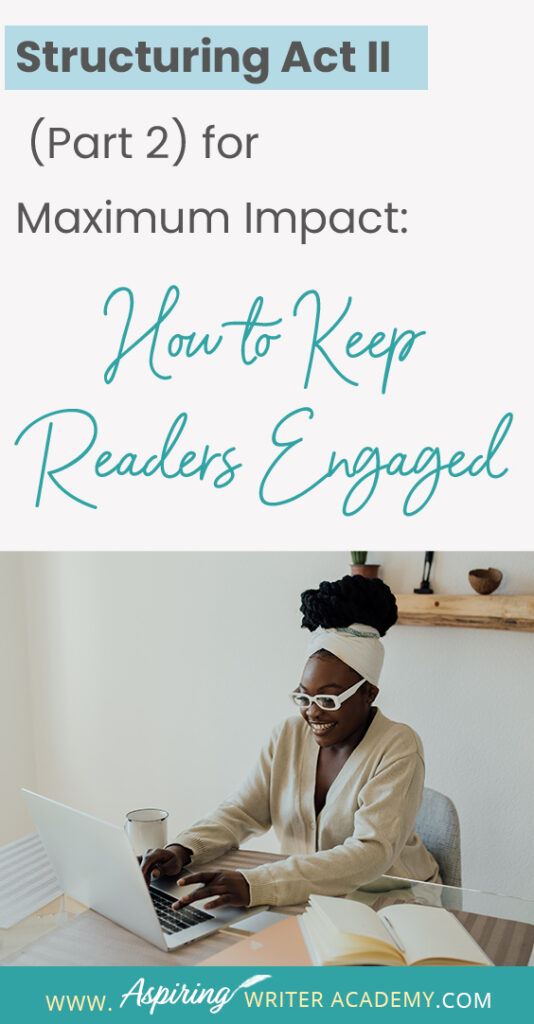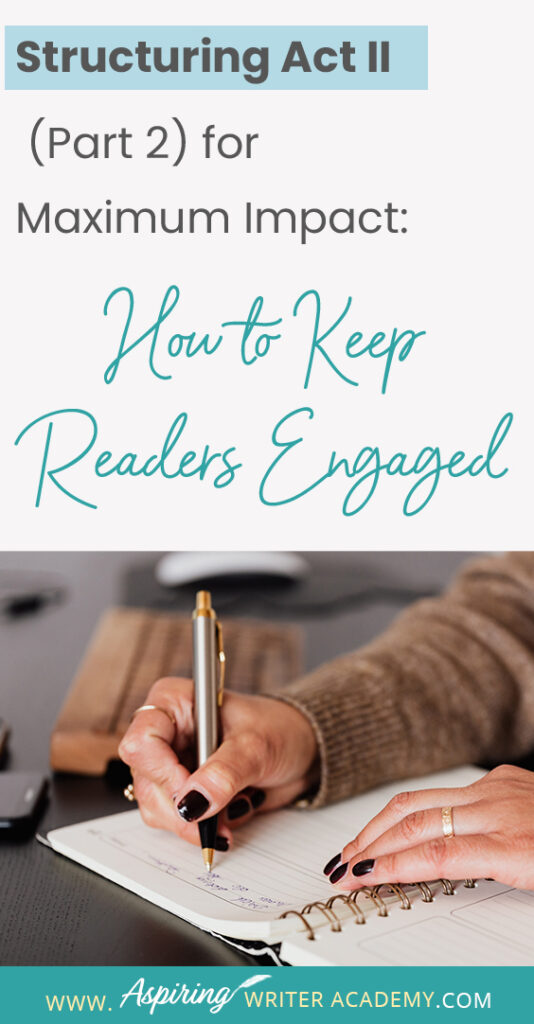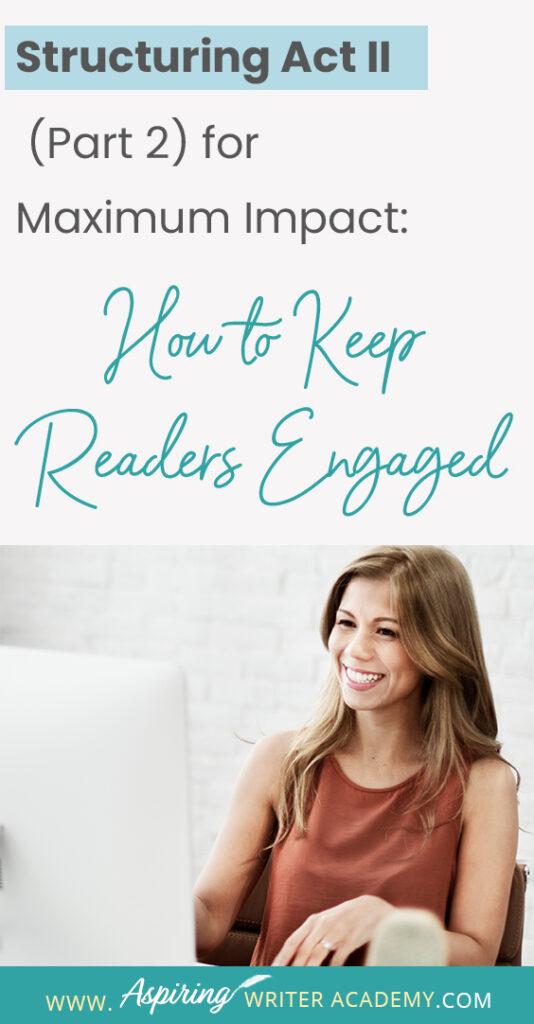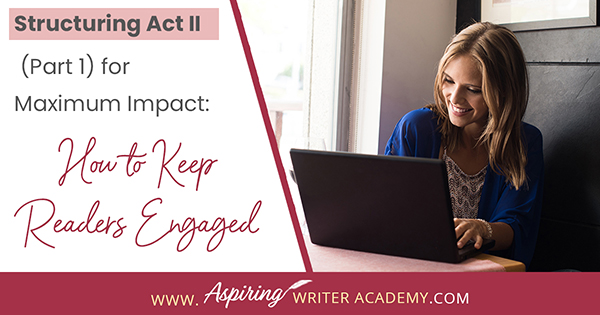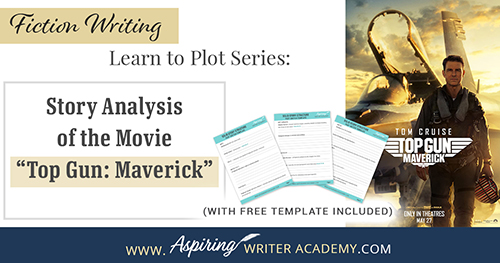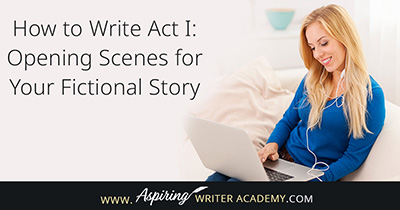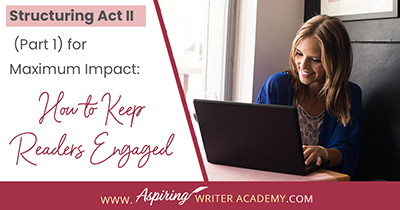Structuring Act II (Part 2) for Maximum Impact: How to Keep Readers Engaged
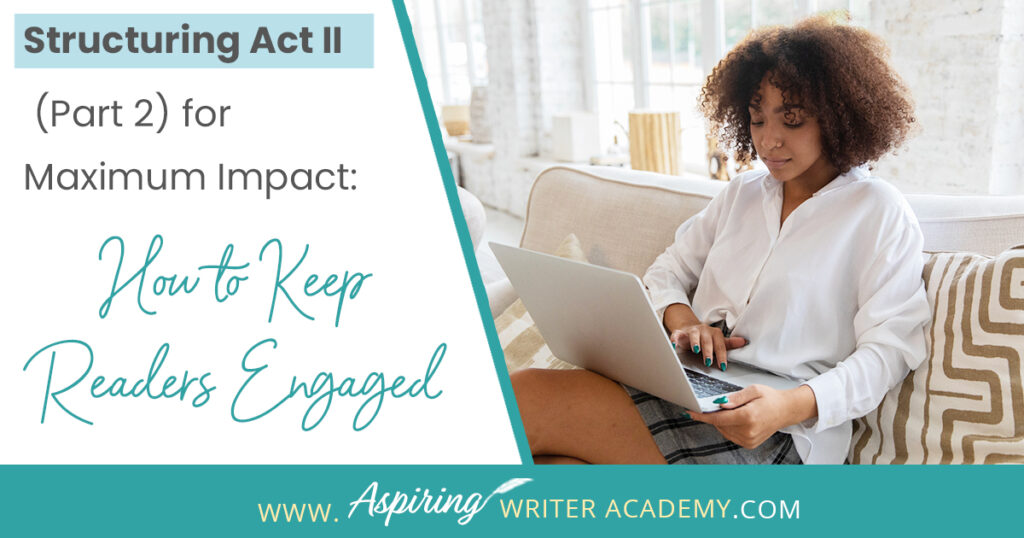
When using the 3-Act-Structure in fiction writing, Act I begins the story, and Act III contains the story ending. But what happens in the middle of the story? Are there specific turning points that should be included?
In Structuring Act II (Part 2) for Maximum Impact: How to Keep Readers Engaged, we cover the key components of the second half of Act II, from the Midpoint Reversal to Plot Point II, to help you create a memorable fictional story to keep readers engaged and turning pages.
How do you structure Act II of a Fictional Novel?
Act II begins right after the protagonist makes the decision to go on the story journey. In Act I, an Inciting Incident presented the protagonist with a major obstacle or problem that must be solved. In Act II the protagonist takes active steps to overcome that problem. The protagonist may learn new skills or gather a team, and experience both challenges and triumphs which test his character and strengths.
Right before the midpoint of the novel, the protagonist may think the goal has been achieved with a Temporary Triumph, but a Midpoint Reversal immediately follows, which changes everything. As the protagonist takes further steps to defeat the opposition, the character may experience a Calm Before the Storm before the Black Moment leads him to believe he has failed, and all is lost. This leads directly to Plot Pt. II where the characters separate from one another, leaving the protagonist alone before the Act III Climax.

This post is Part 2 of a two-part segment discussing the structure of Act II in a fictional novel. To access Part 1 click this link: Structuring Act II (Part 1) for Maximum Impact: How to Keep Readers Engaged
Follow along as we discuss Structuring Act II (Part 2) of your fictional novel in 3 steps:
1. Structuring Act II (Part 2) for Maximum Impact: Key components of the Protagonist’s Story Journey.
2. What is a Pinch Point? How can Pinch Point #2 be used to motivate your character when structuring Act II (Part 2) for maximum impact?
3. How to keep readers engaged and turning pages by raising the stakes and building tension, conflict, and suspense into Act II of your fictional story.
1) Structuring Act II (Part 2) for Maximum Impact: Key components of the Protagonist’s Story Journey.
Right before the Midpoint of your fictional novel, your protagonist experiences a “win” of some sort which makes him (or her) believe he is on the cusp of achieving his goal. But this is not the end of the story.
- MIDPOINT REVERSAL
Act II (Part 2) starts with a big reversal, the second major turning point in the story, in which everything changes. What the character believed to be true may turn out to be false, a lie. A big secret may be revealed here, or a new larger, more dangerous threat may come into play. How can the story change in a different direction?
Usually, it is the antagonist or villain who acts to create this turning point, just as he did at the Inciting Incident in Act I. Remember it is the opposition to your protagonist’s goal that creates tension and conflict throughout the story.
The protagonist may become aware of what is really going on at this point in the story, he may see the antagonist’s true intentions. The protagonist is now better informed and uses the skills and knowledge he’s gained in Part 1 of Act II, to now take more proactive steps to achieve his goal and overcome the opposition. Your protagonist is going to fight smarter and harder and with more focus and intention.
- PINCH POINT #2
Halfway through Act II (Part 2) your protagonist may encounter a moment that tugs on his emotions and reminds him of all he can gain if he overcomes the opposition and achieves his goal. This motivates the character to press onward with renewed vigor.
- CALM BEFORE THE STORM
Similar to the Temporary Triumph, the protagonist experiences a moment where the story takes a pause and the characters connect, come to an understanding, experience another “win” and believe that all will be well. A moment of optimism and hope.
- BLACK MOMENT
This is the darkest, bleakest point of your fictional novel. The antagonist has gained the upper hand and does something to make your protagonist believe that all is lost. The protagonist believes that he has failed.
Or perhaps it is the protagonist himself which causes this game-changing, third turning point in the story as he falls back on his original fears and old habits. The Black Moment is usually where the character’s past rises up to haunt him. This could lead the protagonist to make poor judgement calls or decisions. Perhaps because he hasn’t fully completed his character arc and learned his story “lesson.”
Example:
If your character has slowly been learning to trust, something may happen at this point in the story to make him revert to his old ways of mistrusting others. This lack of trust could lead him to temporarily separate from others until Act III when they regather to make amends.
Another possibility is the protagonist may make a mistake here that he will later regret because he doesn’t have all the information.
Example:
A general of an army may send a troop of soldiers the wrong way, straight into the trap set up by the enemy forces because he didn’t know the enemy had discovered a map of their intended route.
Or
The protagonist may think their romantic love interest has betrayed him, and they argue and separate, because he does not know all the facts, and that the love interest had indeed been targeted and “set up” by the villain / antagonist. Or perhaps the protagonist was not privy to the details revealing that the romantic love interest had been acting in his best interest to protect him from harm.
- PLOT POINT 2 REVERSAL
The turn of events at the Black Moment causes the protagonist and the other characters (or team) to separate at Plot Pt. 2.
Either the antagonist / villain actively caused this separation (example: kidnapping one of the characters), or the antagonist / villain did something to cause the protagonist to argue with or separate from his team members or romantic interest. (Example: In a romance, the protagonist and the romantic interest may have a big quarrel and go their separate ways.)
While Plot Pt. I brought the characters in the story together (ending Act I), Plot Pt. II is a reversal where the characters are driven apart, either by force or by their own choosing (ending Act II.) This leaves the protagonist alone before the Climax in Act III.
2) What is a Pinch Point? How can Pinch Point #2 be used to motivate your character when structuring Act II (Part 2) for maximum impact?
* A Pinch Point is an emotional moment in the story that causes the protagonist to pause and think about the consequences tied to the achievement of his story goal.
The protagonist may see or hear something that causes him to react emotionally. The character may have to confront a heart-tugging dilemma. The event ‘pinches’ his emotions and pulls on his heart-strings and reminds him why his goal and this journey is important to him.
* There are usually Two Pinch Points in a fictional novel. The first occurs halfway through Act II (Part 1) and the second occurs about halfway through Act II (Part 2). While Pinch Point #1 may lead the protagonist to see all he has to lose if he does not press forward with his goal, Pinch Point #2 leads him to see all he might gain. What will he win?
The protagonist is more confident in the second half of Act II and starts to believe in himself. He can envision himself winning. Both pinch points serve to motivate the character to press on with renewed vigor to achieve the story goal and overcome the opposition. He will not give up!
Example:
In the second half of Act II (Part 2) of the Hunger Games by Suzanne Collins, the protagonist, Katniss Everdeen, is faced with the death of her young friend, Rue, which reminds her that she is in this savage game because she took her young sister’s place, to save her from this very fate. It reminds her how corrupt the governing system of society really is and why she must find a way to stay alive, win, and take them down. As a pledge of her renewed commitment to her goal, she uses the old hand gesture of solidarity between the people of the different districts toward the camera for all to see that she is not giving up! This in turn inspires others to fight against the district’s tyrannical oppressors in hope of a changed, better future.
Watch on Amazon: Click Here
Buy the Book on Amazon: Click Here
3) How to keep readers engaged and turning pages by raising the stakes and building tension, conflict, and suspense into Act II of your fictional story.
Let’s talk about how to embed Conflict, Tension, and Suspense into your fictional novel for maximum impact to keep readers engaged and turning pages.
There should be three major turning points in your story. Of course, there should be opposition and conflict in every chapter and scene, but what I am referring to is three big events or significant moments that turn the story around in a different direction in a big way.
Plot Pt. I (at the end of Act I) is the protagonist’s decision to go on the story journey, to take action to overcome the problem the antagonist threw his way at the Inciting Incident. This becomes his story-worthy goal, takes him out of his comfort zone, and may even take him to a new location or thrust him into a new situation.
Example:
A single, childless, corporate CEO may receive news that her sister has passed away, leaving the CEO to raise a three-month old baby. The decision to adapt to this new situation and raise this baby is Plot Pt. I.
The Midpoint Reversal is the second major turning point. Just when the reader thinks the protagonist may achieve his goal, something unexpected happens to turn the story around once again. Now the protagonist must strategize anew.
Example:
Just when the protagonist thinks the romantic interest is going to propose she sees him with another woman, or she finds he may be wanted for murder. How will she deal with this? What will she do now?
The third major turning point is Plot Pt. II (at the end of Act II), when the characters either decide to separate or are forced apart by the opposition.
Example:
At Plot Pt. II of J.R.R. Tolkien’s The Fellowship of the Ring, the hobbit, Frodo, decides to leave the team and continue the journey to destroy the One Ring in the fires of Mount Doom on his own. (This decision was instigated by a Black Moment event where one of the team tried to take the ring from Frodo, losing his trust.)
Watch on Amazon: Click Here
Buy the Book on Amazon: Click Here
Another Example:
At Plot Pt. II in the movie, Top Gun: Maverick, the protagonist is leading a dangerous mission against the enemy and his plane is shot down, leaving him on his own, on foot, and without his team, to try to escape the opposition.
Click to see our blog post: Learn To Plot Fiction Writing Series: Story Analysis of the Movie “Top Gun: Maverick”
Each of these big turning points occur before the ACT III Climax to build up the tension and suspense for when the protagonist and the opposition come face to face for a final showdown.
Just like there was the Temporary Triumph (where all is good) immediately followed by the Midpoint Reversal (where everything is bad), the second half of Act II contains a similar Calm Before the Storm moment (where all is good) immediately followed by the devastating Black Moment (where everything is far worse than ever before.) These ups and downs, and highs and lows in the story give your novel rhythm and keep the readers engaged to see what new development will occur. The reader will wonder what will happen next.
Try to keep these game-changing reversals unpredictable but logical to the story. These turning points are also a good place to insert cliffhangers. Each turning point should also be more devastating than the last to raise the stakes and build suspense.
Plot Pt. 2 is pivotal because it leaves the protagonist alone to consider all that has gone before and all that lies ahead before the final confrontation with the antagonist at your fictional story’s climax in Act III.
Conflict and suspense and story tension are what keep readers engaged and turning pages. Implement the components of the 3-Act-Structure and you will lift your writing to a whole new level.
We hope you have enjoyed our post, Structuring Act II (Part 2) for Maximum Impact: How to Keep Readers Engaged, and that you have gained some valuable insight into which components should be included when writing the second half of your fictional novel.
If you have any questions on fiction writing or would like to leave a comment below, we would love to hear from you!
Continue to ACT III: How to Create a Captivating End to Your Fictional Story to learn even more!
Other Posts You May Like:
You may also want to download our free Brainstorming Your Story Idea Worksheet with fill-in-the-blank templates to help you further develop your characters and deepen your story.
Do you find it difficult to create compelling antagonists and villains for your stories? Do your villains feel cartoonish and unbelievable? Do they lack motivation or a specific game plan? Discover the secrets to crafting villains that will stick with your readers long after they finish your story, with our How to Create Antagonists & Villains Workbook.
This 32-page instructional workbook is packed with valuable fill-in-the-blank templates and practical advice to help you create memorable and effective antagonists and villains. Whether you're a seasoned writer or just starting out, this workbook will take your writing to the next level.
Our Goal for Aspiring Writer Academy is to help people learn how to write quality fiction, teach them to publish and promote their work, and to give them the necessary tools to pursue a writing career.

ENTER YOUR EMAIL BELOW
TO GET YOUR FREE
"Brainstorming Your Story Idea Worksheet"
7 easy fill-in-the-blank pages,
+ 2 bonus pages filled with additional story examples.
A valuable tool to develop story plots again and again.
Other Blog Posts You May Like
How to Use Setting to Intensify Your Fictional Scenes
How to Manipulate Pacing to Increase the Intensity of Your Scenes in a Fictional Novel
How to Brainstorm a New Novel Using Goal, Motivation, and Conflict
Fiction Writing: How to Plot a Story where the Antagonist is an ‘Invisible Foe’
Fiction Writing: Create a Storyboard to Map Out Your Scenes
3 Ways to Avoid Writing ‘Episodic’ Scenes in Fiction
How to Write Act I: Opening Scenes for Your Fictional Story
Brainstorming Fiction: What to Do When Your Story Gets “Stuck”
How to Plot Your Fictional Novel (with Free Template Included)
5 Questions to Create Believable Villains
Why Your Characters Need Story-Worthy Goals
How to Captivate Your Readers with Scene-Ending Hooks
Scene & Sequel: The Secret to Plotting an Epic Novel
Scene & Sequel: The Secret to Plotting an Epic Novel (Part 2)

is a multi-published author, speaker, and writing coach. She writes sweet contemporary, inspirational, and historical romance and loves teaching aspiring writers how to write quality fiction. Read her inspiring story of how she published her first book and launched a successful writing career.

